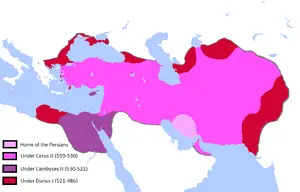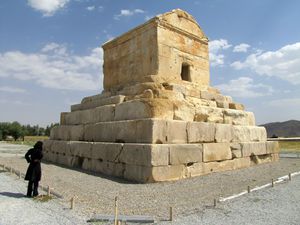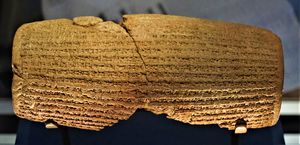Difference between revisions of "What was the Achaemenid Persian Empire"
(Created page with "300px|thumbnail|left|Map of the Achaemenid Empire The ancient Near East was the location of several impressive empires. From about 1500 unt...") |
(No difference)
|
Revision as of 20:41, 10 October 2018
The ancient Near East was the location of several impressive empires. From about 1500 until 1075 BC, Egypt’s New Kingdom spanned from the Levant (modern day Israel and Lebanon) down through Egypt into most of Nubia (modern day Sudan). The Assyrians then conquered all of Mesopotamia in the early first millennium BC and ruled over the Levant and Egypt before their empire collapsed in the late seventh century BC. The Neo-Babylonians inherited much of the Assyrians’ empire and were the dominant political force in the region until they were replaced in the sixth century BC by the Achaemenid Persians.
During its height in the fifth century BC, the Achaemenid Persian Empire was the most vast of any empire that came before it and comprised the most diverse collection peoples in the world. It stretched from Bactria (modern day Afghanistan) in the east to Egypt in the west and from Anatolia in the north to Arabia in the south. Within that immense geographic area people from scores of different ethnic groups, who spoke different languages and followed different religions, were all subjects to the “Great King” of the Achaemenid Empire. The manner in which the Achaemenid kings were able to pacify such a large and diverse population for so long has been a subject of interest for modern scholars for some time. An examination of the ancient sources, combined with archaeological discoveries, reveals that the Achaemenid kings followed a “hands off” policy when it came to the cultures of their foreign subjects. The Achaemenids appointed satraps in the conquered provinces to collect taxes and to mitigate rebellious activity, but they left the native religious cults unmolested for the most part and sometimes even participated as a show of good faith. Since religion was of paramount importance in the ancient Near East, this policy ensured that that Achaemenid Empire would be the most enduring until the Romans conquered the Mediterranean and Near East about 500 years later.
Contents
The Achaemenid Empire
The Achaemenid Empire originated with the Indo-European ethnic group known as the Persians, who came from a tribal society in the region of Fars in southern Persia (modern Iran). [1] For most of their early history, the Persians played little role in the machinations of geo-politics in the ancient Near East, living an existence as semi-nomadic pastoral people, but the region eventually became dominated by the sedentary and more civilized Medes. The Medes were actually closely related ethnically to the Persians as both were Indo-Europeans and probably spoke a similar language, although they saw themselves as distinct groups. [2]
Not all of the Persians were happy to remain subordinate to the Medes, though. A clan descended from a man named Achaemenes, which is the origin of the name of the dynasty, rose up in rebellion against the Medes in 553 BC. The rebellion was led by Cyrus II, more commonly known as Cyrus “the Great” (ruled 559-530 BC), who took the Mede capital of Ecbatana in 550 BC, thereby ending the Median Empire and establishing the Achaemenid Empire. [3] A period of rapid Achaemenid Persian expansion soon followed with the conquest of Lydia around the year 546 BC, Babylon and Mesopotamia in 539 BC, and Egypt under King Cambyses (reigned 530-522 BC) in 525 BC. [4] By 525 BC, the Achaemenid Persians proved to the world that they were excellent warriors, but their administrative and diplomatic skills were still unproven.
Three Examples of the Achaemenid Persian “Hands Off” Policy
The basic political theory that governed the Achaemenid Persian policy toward their subject peoples can best be described as “co-operation rather than coercion.” This idea can be seen visually on many of the reliefs from the Achaemenid capital city of Persepolis, where the subject peoples are depicted freely bringing gifts and tribute to the Great King. [5] Although the king is clearly shown in a superior position in these reliefs, the subject peoples are never bound and the king was reliant on his subjects for support, which was different than earlier versions of Mesopotamian and Near Eastern models of kingship. [6] The Achaemenid Persians put this policy into effect throughout their empire, but it was most apparent in Babylonia/Mesopotamia, with the Jews, and in Egypt.
After Cyrus and the Persians conquered Babylon in 539 BC, he commemorated the event by commissioning a historical text known today as the “Cyrus Cylinder.” The text states that the last Neo-Babylonian king, Nabonidus (ruled 556-539 BC), did not carry out the proper rituals of the Marduk cult, which was the primary god of Babylon. The cylinder states:
“Without any battle, he made him enter his town Babylon, sparing Babylon any calamity. He delivered into his (i.e. Cyrus’) hands Nabonidus, the king who did not worship him (i.e. Marduk). All the inhabitants of Babylon as well as of the entire country of Sumer and Akkad, princes and governors (included), bowed to him (Cyrus) and kissed his feet, jubilant that he (had received) the kingship, and with shining faces. Happily they greeted him as a master through whose help they had come (again) to life from death (and) had all been spared damage and disaster, and they worshiped his (very) name.” [7]
How much of the cylinder was historical fact and how much was propaganda is open to debate, but even having the cylinder commissioned shows that the Persians were concerned about how they were seen by the inhabitants of the older Mesopotamian civilization. The evidence shows that the Persians certainly allowed the Marduk cult to continue operating in Babylon as it had for centuries and archaeological excavations from other sites in Mesopotamia indicate that the policy was employed there as well. Brick inscriptions from the southern Mesopotamian city of Uruk dated to the reign of Cyrus prove that the Persian king repaired religious temples in that city. A cuneiform inscription dated to Cyrus’ fourth year of rule states that he also funded efforts to reorganize native Mesopotamian cults in the cities of Eshnunna and Akkad. [8]
Perhaps the most widely known example of the Achaemenid Persians’ “hands off policy” toward their subject peoples concerned the Jews of the Babylonian captivity. A large number of the people of the Kingdom of Judea had been living in Babylon since the reign of the Neo-Babylonian king, Nebuchadnezzar II (reigned 605-562 BC), who forcefully placed them there after sacking Jerusalem (2 Kings 24-25). It is quite possible that Cyrus worked out an arrangement with the leaders of the Babylonian Jewish community before he entered the city, whereby they would give him intelligence and facilitate the conquest of the city. [9] It was based on that where a relationship was formed whereby the Jews were allowed to once again freely practice their religion and live in their homeland.
According to the Old Testament, Cyrus was seen as the anointed of Yahweh the Jewish god (Isa. 45:1-3) because he allowed the Jewish community to return to Judea with all of their material possessions to build the Second Temple (Ez. 6:2-5). Although the Jews saw Cyrus’ treatment of their community as a watershed moment in their history, it was a carefully calculated political move by Cyrus and part of the overall political program of their “hands off approach” to their subject peoples. [10]
Of all the places where the Achaemenid Persians pursued the tolerant approach to their subject peoples, Egypt presents the most interesting case. Along with Mesopotamia, Egypt was the site of the one of the world’s oldest civilizations, but unlike the case with Babylon, the Egyptians fiercely resisted Persian domination. The Persian conquest of Egypt was done by Cambyses (reigned 530-522 BC), who led a massive attack into the Nile Delta in 525 BC. The invasion was recorded in both classical and Egyptian sources, including Herodotus (Book III, 10-11) and by the second century AD Macedonian historian, Polyaenus. According to Polyaenus, when Cambyses saw how aggressively the Egyptians were resisting the Persian invasion, he ordered his troops to lob sacred animals from catapults in order to break the will of the Egyptian defenders. [11] Once the Persians defeated the Egyptians, Herodotus claimed that Cambyses embarked on a series of sacrilegious activities, such as whipping the mummy of the Egyptian king Amasis and killing the sacred Apis Bull. [12] Although many modern scholars are quick to point out that these claims may have been exaggerated and were probably a result of anti-Persian bias, a hieroglyphic inscription on a statue of an Egyptian noble claims that the invasion wrought great destruction to the temple of the goddess Neith in the city of Sais. [13] Once Cambyses took control of Egypt, he vanquished the Twenty-Sixth Dynasty and established Achaemenid Persian rule in the Nile Valley as the Twenty-Seventh Dynasty.
The extent of the damage Cambyses’ invasion of Egypt may be open to discussion, but there is no doubt that it left a negative impact on the Egyptian people, one that would cause problems for the Persians’ policy of tolerance toward their subject peoples. There is evidence that Cambyses tried to rectify some of the damage he caused by ceremoniously burying an Apis bull, which would run counter to Herodotus’ claim that he killed one of the bulls in a fit of rage. Epitaph stelae from the Serapeum, the subterranean internment chambers of the sacred bulls, shows that one bull was buried there under Cambyses’ rule and another during the rule of Darius I, or Darius “the Great” (ruled 522-486 BC). [14]
The same statue that relates how Cambyses’ invasion brought destruction to the city of Sais also chronicles how Darius I ordered the temple rebuilt. The following text, written from the perspective of the statue owner, who was a high priest of Neith and physician, also tells how the priest established a new school within the precinct of the temple.
“The majesty of the King of Upper and Lower Egypt, Darius, who lives forever, ordered me to return to Egypt, while his majesty was in Elam as he is the great prince of all foreign lands the great ruler of Egypt, in order to establish the office of Temple of Life (of Sais) throughout the ruins. The foreigners from foreign lands took me to the land, delivering me to Egypt as the lord of the Two Lands commanded. I did as his majesty commanded to me. I organized them with all of their scrolls from sons of men, no low class sons were there. I placed them in charge of all knowledge.” [15]
Finally, there is evidence that Darius I took an interest in even bigger building projects in Egypt. A small temple located in the el-Kharga Oasis was built primarily during the Twenty-Sixth Dynasty to honor the god Amun. Construction was temporarily halted after the Persian invasion, but resumed under Darius I, as evidenced by inscriptions of his name in the temple. [16]
Conclusion
The Achaemenid Persians created the largest and most diverse world empire in the world at the time, which was no easy task because they had to constantly deal with the possibility of rebellions by people who had their own long and glorious histories. In order to placate their subject peoples, the Persians adopted a policy of tolerance and a “hands off approach” toward their subject peoples’ cultures and religions. Some of the Achaemenid kings even took the policy a step further by participating in and actively patronizing their subjects’ native cults. In the end, the policy helped placate an often hostile mix of peoples.
References
- ↑ Briant, Pierre. From Cyrus to Alexander: A History of the Persian Empire. Translated by Peter T. Daniels. (Winona Lake, Indiana: Eisenbrauns, 2002), pgs. 17-18
- ↑ Briant, p. 25
- ↑ Briant, p. 32
- ↑ Briant, pgs. 36-52
- ↑ Ehrenberg, Erica. “Persian Conquerors, Babylonian Captivators.” In Regime Change in the Ancient Near East and Egypt: From Sargon of Agade to Saddam Hussein. Edited by Harriet Crawford. (Oxford: Oxford University Press, 2007), p. 95
- ↑ Walser, Gerold. Die Völkerschaften auf den Reliefs von Persepolis: Historiche Studien über den sogenannte Tributzug an der Apadanatreppe. (Berlin: Akadamie Verlag, 1966), p. 26
- ↑ Pritchard, James B, ed. Ancient Near Eastern Texts Relating to the Old Testament. 3rd ed. (Princeton, New Jersey: Princeton University Press, 1992), p. 315-6
- ↑ Jursa, Michael. “The Transition of Babylonia from the Neo-Babylonian Empire to Achaemenid Rule.” In Regime Change in the Ancient Near East and Egypt: From Sargon of Agade to Saddam Hussein. Edited by Harriet Crawford. (Oxford: Oxford University Press, 2007), pgs. 77-78
- ↑ Briant, p. 46
- ↑ Briant, p. 48
- ↑ Polyaenus. Strategams of War.<i> Translated by R. Shepard. (Chicago: Ares Publishers, 1974), Book VII, X</span> </li>
- ↑ Herodotus. <i>The Histories.</i> Translated by Aubrey de Sélincourt. (London: Penguin, 2003), Book II
- ↑ Posener, Georges. <i>La première domination Perse en Égypte: Recueil d’inscriptions hieroglyps.</i> (Cairo: L’Institut Français d’Archéologie Orientale, 1936), p. 19
- ↑ Posener, pgs. 30-41
- ↑ Posener, p. 22
- ↑ Cruz-Uribe, Eugene. “The Hibis Temple Project 1984-85 Field Season, Preliminary Report.” <i>Journal of the American Research Center in Egypt.</i> 23 (1986) p. 164
</ol>




